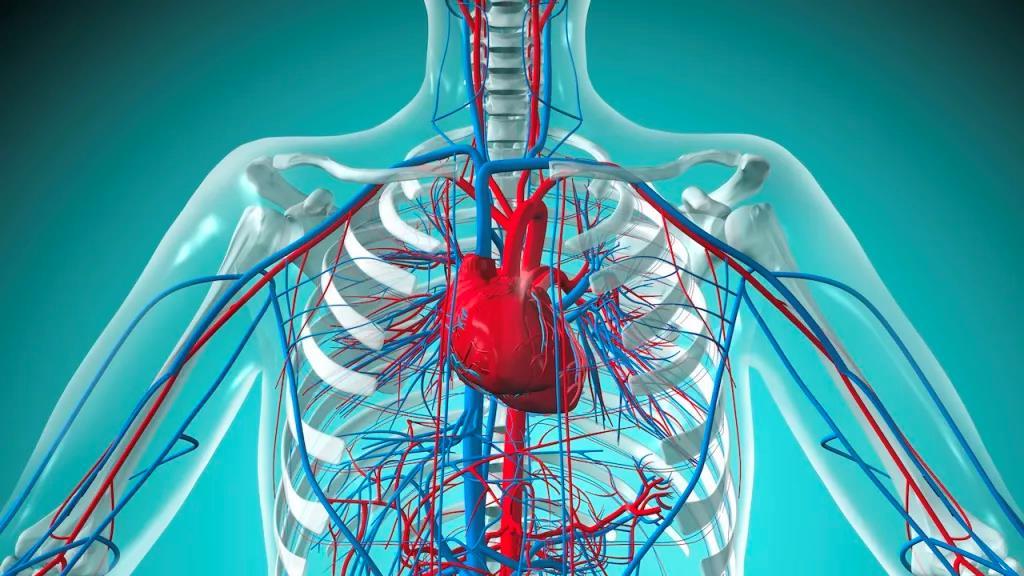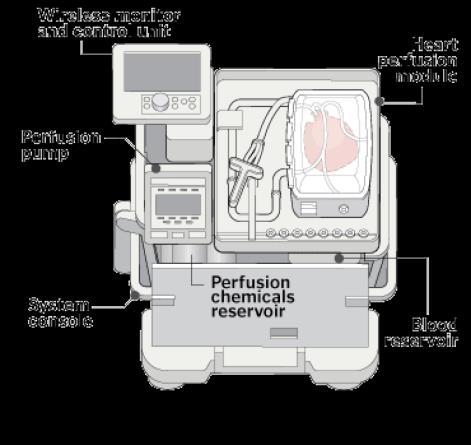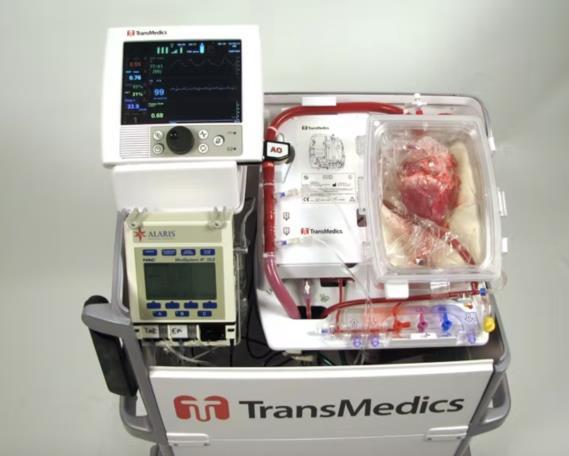
14 minute read
Adelaide Thompson (Year 12
Heart in a Box vs Static Cold Storage
Adelaide Thompson (Year 12) The Illawarra Grammar School, 10/12 Western Avenue, Wollongong, NSW, Australia, 2500
Advertisement
Image credit: Livescience, 2021
Introduction
Heart conditions are a non-infectious disease that interrupts the heart's function of pumping blood efficiently throughout the body as a result of structural problems or the build-up of plaque that causes blood clotting. There are many conditions of the heart that require heart transplants to eliminate the issues that the person is having. These conditions are:
● Myocardial infarction (Heart attacks) ● Cardiomyopathy ● Arrhythmias (irregular heartbeat) ● Heart defects detected at birth (congenital) ● Pulmonary hypertension (high blood pressure) ● Sudden Aortic dissection (Hopkins Medicine, 2022)
The end-stage of heart failure is a disease in which the heart muscle is failing significantly in its attempt to pump blood to the entire body. Thus, meaning that no other treatments are not effective in keeping the heart thoroughly pumping blood. Therefore, heart transplants are extremely important in providing people who suffer from heart conditions a chance to live life to their full potential. (Hopkins Medicine, 2022).
The World Health Organisation (WHO) recorded in 2019, that the world’s leading cause of death was Ischaemic heart disease (build-up of plaque in the arteries), resulted in 8.9 million deaths worldwide (WHO, 2022) and Professor of medicine, Howard J Eisen says that “more than 5,000 cardiac transplants occur each year worldwide” (Hiward Eisen, 2021). As heart conditions are clearly prevalent amongst our society, it is important to have technologies that allow the prevalence of the condition to become subsided. Heart in a Box is a new heart transplant technology that was developed in 2014, that allows the heart to keep functioning until it is transplanted into the receiver, unlike the traditional heart transplant method, the Static Cold Storage, where the heart is placed in ice, until ready for transplantation. Therefore, this report evaluates the effectiveness of ‘Heart in a box’, compared to the ‘Static Cold Storage’ against heart disease. It has been hypothesised that Heart in a Box will be sufficiently more effective in heart transplants because of the hyperthermic system, the extended time period, testing the heart before transplantation, and the clinical trial experiment for the extended criteria that is currently being conducted by the founding company of Heart in a Box, Transmedics.
What is the Static Cold Storage technique and How does it work?
The Static Cold Storage (SCS) has been the pioneer solution for organ transplants and organ preservation.
Before the Static Cold Storage, the donor heart will be flushed using a preservation solution, which will flush the blood out of the heart and it also provides nutrients and sometimes oxygen, carries away toxic metabolites and delivers buffers which absorb the build-up of lactic acid. Then, after flushing the heart, it is then submerged in the sterilised preservation solution. The preservation period is the transportation process for the heart. The preservation solution is set between 0-4°C, this hypothermic setting slows down the cell metabolism and reduces the need for oxygen, to prevent tissue injury, and death of the cells due to the lack of oxygen. The general cold solution strategy that is used is the Collins Solution. It is based on a combination of high potassium ion content and osmotic barrier supported by glucose (Guibert et al 2011). Prior to the machine perfusion, the heart is flushed out and then connected to its artery to the perfusion circuit and submerged in the cassette filled with the preservation solution at 5°C, and the solution is pumped (Faro et al 2015).

What is Heart in a Box and How does it work?
Heart in a box is a new technology that was developed in 2014 by Transmedics, an organ therapy transplant company. Heart in a box allows a donor heart to keep beating and functioning outside the body.
When Heart in a Box was developed, the discovery was made on how to transplant donor’s hearts that had stopped after death successfully. The Heart in a Box is composed of an organ specific perfusion machine with disposable and non-disposable parts and a compact wireless monitor. Image: Schematic representation of static cold storage and machine perfusion, 2014
The transplant process begins when the donor's heart is connected to a sterile circuit and once the heart is housed inside the portable device, the heart is reanimated, preserved with a unique fluid developed by the Victor Chang Cardiac Research Institute (Victor Chang Cardiac Research Institute 2022). The monitor that the heart is attached to, allows the cardiologist to see the heart is functioning properly by observing electrical activity that is always occurring in the heart, as the monitor displays a real-time system of organ measurements that include, aortic pressure, coronary flow, blood pressure and heart rate. The donor’s blood is warm (34°), oxygenated and is nutrient filled, which allows for an extended “out of body” time, and minimises the detrimental effects on the heart, such as tissue damage and the blood not receiving a substantial amount of oxygen, due to the deterioration of cells, if the blood were to be Image: How does Heart in a Box work, Cleveland, 2012 cold. The blood is then supplied and “is pumped through to the aorta, thereby passing blood through the coronary arteries, and deoxygenated blood perfuses through the left atrium through the coronary sinus and passes through the tricuspid valve to the right ventricle. The blood is then ejected through the pulmonary artery to the blood oxygenated and then finally is returned to the receiver” (Saez et al, 2014). Once the heart has been assessed and the cardiologist is satisfied, the heart is then transplanted into the recipient.

Advantages and Disadvantages of both Technologies
Heart in a Box is a new technology that has eliminated disadvantages from older heart transplant techniques, like the Static Cold Storage or has improved the disadvantages that the Static Cold Stage consists of. However, Heart in a Box still contains disadvantages compared to the Static Cold Stage.
Firstly, “OCS Heart is the only FDA approved technology for extracorporeal perfusion and preservation of Donor hearts in the U.S.” (Transmedics, 2022). Heart in a Box is the first commercially available system that allows the donor heart to be maintained in a warm perfused oxygenated state during the transfer period. As a result of this, Australia’s home of heart research, Victor Chang Cardiac Research Institution, says that Heart in a Box “reduces the amount of damage that can occur in the heart” and it “reduces the number of muscle cells that die” during the time that the heart is in the box (Victor Chang Cardiac Research Institute 2022). It reduces the amount of damaged that can occur in the heart, because the technique used is hyperthermic, meaning that the heart is consistently pumped with nutrient filled, Image: Trandmedics, 2022 warm blood (34°) throughout the transplant period, compared to the Static Cold Storage where the technique is hypothermic, meaning that the heart is resting at a cold temperature (4°), this increases the likelihood for tissue injury on the heart and muscles cells dying due to the lack of oxygen that the cells are receiving. Victor Chang Cardiac Research Institution also states that Heart in a Box is “making the heart more resilient to transplantation” and “improves heart function when it is restarted”, due to the heart still receiving oxygenated blood, allowing cellular respiration. Thus, minimising the amount of cell death that could potentially occur.

A major advantage that Heart in a Box has compared to the Static Cold Storage technique is it extends the amount of ischemic time - the amount of time the heart has outside the body. Transmedics Organ Care System (OCS), the founding company of Heart in a Box says that the heart can remain outside the body for up to “12 hours”, juxtaposed to the Static Cold Storage, where the heart can last for four hours. Director, UCLA Heart and Lung Transplants, Doctor Abbas Ardehali says, “OSC allows us to take the time variable out of the equation… A good illustration of this is, on an annual basis more than thirty or forty in Hawaii go unused because of the distance, these hearts cannot be transported to the mainland. This technology can potentially afford those hearts to the rest of the country” (Organ Care System OCS Heart, Transmedics, 2019).
Another significant advantage of Heart in a Box is the way the doctors can test the heart's condition before transplanting the heart into the recipient. The digital monitor allows the specialist to monitor the heart's aortic pressure, the rate in which it is beating, the blood pressure and the coronary flow as well as a live electrocardiogram (ecg). If the heart does begin to beat abnormally, the machine's setting can be adjusted to change the blood flow. This technology is positive because it optimises the chance of a successful heart transplant as doctors can see if the heart is functioning to a state where it can be transplanted, maximising the recipient's chance of survival. In an academic article by the University of Minnesota, evaluating Heart in a Box, Cardiovascular surgeon, Kenneth Laio says “This gives us time to assess the heart until about 10 minutes before we put it in…We will watch the heart work, pumping, until we are totally satisfied that the heart is usable” (Breining, 2017). Monitoring the heart has shown success for the patient’s post-surgery as seen through Dr Gero Tenderich “PROTECT 1 clinical trial” evaluating the “Safety and Performance of the Organ Care System for Heart Transplants”, the results show that “100% survival of patients 30 days post-surgery” and that “using the OSC allowed for patients
to spend less time on a ventilator and experience a quicker recovery in the hospital” (Science Daily, 2007). In contrast, a comparative study was demonstrated to evaluate heart transplant outcomes using Static Cold Storage technique, showing the mortality rate for the Static Cold Storage 30 days postsurgery was 13% out of the 24 participants (Sandro Spronga, et al, 2021). This survival rate could potentially reflect upon the fact that the Static Cold Storage does not allow doctors to assess the heart before it is transplanted into the recipient, which is a limitation to the recipient because there is a risk of fatality.
Transmedics are conducting an extended trial to “Evaluate the Organ Care System for use with unutilised donor hearts that may not meet current standard acceptance criteria for transplantation”, where 75 patients were enrolled (Transmedics, 2022). In this clinical trial, the target donors were “marginal donors” - people whose hearts might have been rejected by the traditional criteria for heart transplants. If this criterion is effective, more hearts will be available for transplants, therefore, less hearts will be wasted. The types of expanded criteria donor hearts used were:
● “Expected ischemic time >4 hours - 37% ● 20 or more mins of down time - 31% ● LVEF of 40-50% - 28% ● Older donors >55 years - 13% ● Coronary artery disease - 8%” (Transmedics, 2022)
The Static Cold Storage uses the traditional criteria for determining what a good heart looks like for transplantation. This includes:
● A donor who is younger than 55 years old ● A donor with no history of chest trauma or cardiac disease ● No history of low blood pressure or low oxygen in the blood ● A normal electrocardiogram and a normal echocardiogram
This expanded trial will be beneficial in determining whether “unuseful” hearts that fit in the traditional criteria can be used for possible transplants. The expanded trial will also limit the wastage of hearts that wouldn't have been acceptable in the traditional criteria that is used by the Static Cold Storage, because hearts will be acceptable in the new expanded criteria for the future.
However, Heart in a Box is quite costly for an individual, costing $250,000 USD. Thus, representing a barrier that could prevent many hospitals from acquiring the device and people not being able to afford the most substantial treatment they require. Juxtaposed to the Static Cold Storage, where the cost of standard care is from $70 to $205 USD, therefore making the Static Cold Storage significantly more accessible for hospitals to obtain this technique. As a result of Heart in a Box being a new technology, it is difficult to have access to the technology because it is very expensive and there is not a sustainable amount of data to prove the claims that have been made.
Table 1: Advantages and Disadvantages of ‘Heart in a Box’ and ‘Static Cold Storage’
Heart in a Box Static Cold Storage
Advantages
Disadvantages
● FDA approved ● Heart is constantly beating outside the body - cellular respiration still occurs ● Heart is maintained in a warm perfused oxygenated state ● Reduces damage to the heart ● Hyperthermic technique ● Heart is still supplied with nutrients ● Ischemic time increased ● The heart can be monitored ● The expanded trial ● Less expensive ● More accessible to hospitals ● Extensive amount of scientific data
● Expensive ● Difficult to access ● Limited amount of scientific data ● Hypothermic technique (heart is kept cold) - no cellular respiration ● Increased damaged to the heart ● Limited amount of ischemic time ● The heat cannot be monitored ● Heart is not beating ● Heart is not supplied with nutrients ● Traditional criteria only
Evaluation of both technologies
As hypothesised, it is evidently clear that ‘Heart in a Box’ is a technology that is significantly effective as a strategy for heart transplants, which is in need because of the high prevalence of heart disease globally. ‘Heart in a Box’ is a superior technology rather than the ‘Static Cold Storage’ as it is the first commercially available system that allows the donor heart to be maintained in a warm perfused oxygenated state during the transfer period, the heart is constantly beating outside the body, allowing cellular respiration to occur, the heart is maintained in a warm perfused state at 34° and is still provided with the necessary nutrients and oxygen, thus decreasing the risk of damaging the heart. Heart in a Box also increases and extends the ischemic time, allowing the heart to be out of the body for up to 12 hours, unlike the Static Cold Storage technique which has an ischemic time of 4 hours. The expanded trial that Transmedics is conducting is also great for the future of heart transplants as it includes ‘marginal donors’, meaning that there will be a decreased amount of wastage and it is providing more people with hearts. But, considering that Heart in a Box is a new technology, it is difficult for hospitals and individuals to access the technology because it is exceptionally expensive and there is little scientific data to gain greater knowledge about how to improve the technology, contrasting the Static Cold Storage technique where it is significantly less expensive to both hospitals and individuals and easily more accessible. To conclude, ‘Heart in a box’, is extremely more effective compared to the ‘Static Cold Storage’ against heart disease.
References
Akhtar, M 2014, Schematic representation of static cold storage and machine perfusion, Photograph, N.a., viewed 8 May 2022, <https://www.researchgate.net/figure/Schematic-representation-of-staticcold-storage-and-machine-perfusion-Left-before_fig2_275257408>.
Eisen, H 2021, Patient education: Heart transplantation (Beyond the Basics), viewed 8 May 2022, <https://www.uptodate.com/contents/heart-transplantation-beyond-thebasics#:~:text=More%20than%205000%20cardiac%20 transplants,should%20receive%20a%20heart%20transplant.>.
Faris, D 2017, ‘Heart in a Box’ a Big Step Forward for Organ Transplants, ZME Science, viewed 8 May 2022, <https://www.zmescience.com/medicine/heart-in-a-box-a-big-step-forward-for-organtransplants/>.
Greg Breining, G 2017, HEART IN A BOX, N.a., viewed 8 May 2022, <https://med.umn.edu/newsevents/medical-bulletin/heart-box>.
Heart Transplant 2022, John Hopkins Medicine, viewed 8 May 2022, <https://www.hopkinsmedicine.org/health/treatment-tests-and-therapies/heart-transplant>.
Increasing Survival Of Organ Transplant Patients By Reducing Time Interval For Transported Organs 2007, Science Daily, viewed 8 May 2022, <https://www.sciencedaily.com/releases/2007/04/070426144823.htm>.
Jing, L, Yao, L & Zhao, M 2018, Organ preservation: from the past to the future, pdf, viewed 8 May 2022, <https://www.nature.com/articles/aps2017182.pdf?origin=epub>.
Nilsson, J 2021, Non-ischaemic Heart Preservation Versus Standard Cold Storage in Human Heart Transplantation (NIHP2), U.S National Library of Medicine, viewed 8 May 2022, <https://clinicaltrials.gov/ct2/show/NCT04066127>.
OCS Heart 2022, Transmedics, viewed 8 May 2022, <https://www.transmedics.com/ocs-hcp-heart/>.
Saez, D, Zych, B & Sabashnikov, A 2014, Evaluation of the Organ Care System in Heart Transplantation With an Adverse Donor/Recipient Profile, pdf, viewed 8 May 2022, <https://www.annalsthoracicsurgery.org/article/S0003-4975(14)01499-4/pdf>.
Sponga, S, Benedetti, G & Manna, N 2021, Heart transplant outcomes in patients with mechanical circulatory support: cold storage versus normothermic perfusion organ preservation, viewed 8 May 2022, <https://pubmed.ncbi.nlm.nih.gov/33221874/>.
Transplant success with heart-in-a-box method 2020, viewed 8 May 2022, <https://www.hospitalhealth.com.au/content/clinical-services/news/transplant-success-withheart-in-a-box-method-454317287>.
Victor Chang Cardiac Research Institute 2022, Heart in a Box, viewed 26 April 2022, <https://www.victorchang.edu.au/heart-in-a-box>.
Victor Chang Cardiac Research Institute 2022, Heart Transplant Research Breakthrough, N.a., Sydney, viewed 8 May 2022, <https://www.victorchang.edu.au/news/heart-transplant-breakthrough>.
World Health Organisation 2020, The top 10 causes of death, Australian Government, viewed 8 May 2022, <https://www.who.int/news-room/fact-sheets/detail/the-top-10-causes-of-death>.
Wong, Y, Law, J & Sharma, V 2021, Real World Experience with Transmedics Organ Care System in Cardiac Transplantation with Donor Organs Associated with Marginal Risk Factors, The Journal of Heart and Lung Transplants, viewed 8 May 2022, <https://www.jhltonline.org/article/S10532498(21)00583-0/fulltext>.








